![]()
![]()
![]()
Use LEFT and RIGHT arrow keys to navigate between flashcards;
Use UP and DOWN arrow keys to flip the card;
H to show hint;
A reads text to speech;
65 Cards in this Set
- Front
- Back
|
You should empty the tray and disinfect it with? |
With a bleach solution once a week, or more often If necessary. A 10 % bleach solution works well as a disinfectant. |
|
|
Equipment used in routine venipuncture. |
•antiseptics cleaning solution • bandage •collection tubes • gaue pads • gloves • marking pens • needle disposal container • needle holders • needles • syringe with transfer device • tourniquets • winged infusion set [butterflies] |
|
|
Inpatients |
Has been admitted to a hospital. And usually draw their blood at the bedside. |
|
|
Outpatient |
Usually come to you at a phlebotomy drawing station in a clinic or hospital. |
|
|
A tourniquet that has been used should be disposed of to reduce the risk of? |
(MRSA) methicillin- resistant staphylococcus aureus |
|
|
Antiseptics |
Refers to an agent used to clean living tissue. |
|
|
Disinfectant |
Refers to agent used to clean a surface other than living tissue. |
|
|
And antiseptics prevent? |
Sepsis |
|
|
The most common used antiseptics is? |
70% isopropyl alcohol, |
|
|
Isopropyl alcohol is? |
Bacteriostatic, means that it inhibits the growth or reproduction of bacteria but does not kill them. |
|
|
How long should antiseptics be left on contact with the skin for? |
30 to 60 sec. |
|
|
Chlorexiden gluconate or benzalkonium chloride is used for patient that's sensitive to iodine |
Chlorhexidine gluconate should not be used on infants younger than 2 months. |
|
|
After drawing blood what's the next step? |
You need to stop the bleeding by applying pressure to the puncture site. |
|
|
How long does bleeding stops for a patient that's on aspirin or anticoagulant medication? |
10 to 15 minutes |
|
|
Point of a needle? |
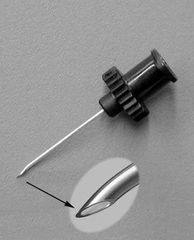
A sharp needle provide smooth entry into the skin with a minimum of pain |
|
|
Bevel of a needle? |
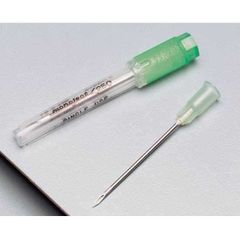
The bevel, or angel, eases the shaft into the skin and prevents the needle from coring out a plug of tissue |
|
|
The largest diameter needles routinely used in phlebotomy are? |
21 to 22 gauge |
|
|
The blood bank use what size needle? |
16 to 18 gauge from donors and transfusion. |
|
|
The smallest size needle commonly use are? |
23 for small, fragile veins. |
|
|
A typical gauge use for routine adult is? |
21 gauge. |
|
|
The needle attaches to the collecting tube or syringe is a? |
Hub |
|
|
The most common needle is the? |
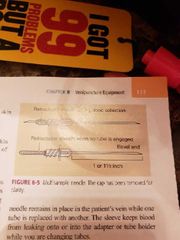
Multisample needle. |
|
|
A syringe is sometimes useful for? |
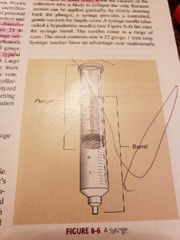
A patient with fragile and small veins. The most common size is 22. |
|
|
Wing infusion or butterfly is used for? 23 gauge size |

Venipuncture with a small veins, such as those in the hand and elderly or pediatric patient. |
|
|
Whole blood |
Is blood collected and mixes mixed with and anticoagulant so that it will bot clot. Whole blood is used for most hematology tests, including blood type and cell counts. And to determine the level of certain hormones and metal. |
|
|
Serum |
Is the fluid portion of blood that remain after clotting. No anticoagulant is used when collecting a serum sample. Complete coloring takes 30 to 60 minutes. Depending on the presence of clot activator. The sample can then be centrifuged to separate the serum. |
|
|
Serum |
Is used for many laboratory tests, including most chemistry and immunology tests. |
|
|
Plasma |
Is the fluid portion of blood, including fibrinogen and other clotting factors, plasma is obtained by collecting whole blood in a tube containing and anticoagulant and then centifuging. |
|
|
Plasma |
Is use for coagulation studies. It is also used for short turnaround time (stat) chemistry tests, when there is no time to wait for clotting to occur before centrifuged. |
|
|
All tubes contain additives except? |
For the glass red top tube. |
|
|
Additive include anticoagulant to prevent? |
Clotting |
|
|
Clot activator to? |
Promote it. |
|
|
Thicoytopic gel is used for? |
Seperate components, and preservatives and inhibitors of various cellular reaction to maintain the integrity of the specimen. |
|
|
What preserves blood cell in integrity? |
(EDTA) ethylenediaminetetraacetic acid |
|
|
What anticoagulant interferes with anticoagulant studies? |
Edta |
|
|
Citrate is used for? |
Coagulation studies |
|
|
(Sps) sodium polyanetholesulfonate is used for? |
Blood cultures because it inhibits certain immune system components that could otherwise destroy blood-borne bacteria and neutralise antibiotics that the patient may be taking. |
|
|
Heparin is used for? |
Plasma chemistry determination and for blood gas determination. |
|
|
Potassium oxalate, combine with sodium flouride or iodoacettate is used for? |
Glucose determination |
|
|
Sodium flouride inhibits? |
Glycolysis and can be used for glucose determination. |
|
|
Clotting in plain serum tube takes about? |
60 minutes |
|
|
Clotting in serum tube with clot activator takes? |
Only 30 minutes. |
|
|
Polymer gel also called? |
Thixotropic gel. |
|
|
Polymer gel or thixotropic gel |
Is an inert synthetic substance whose density is between that of cells and that of blood serum or plasma. |
|
|
Color coded tops and there use |
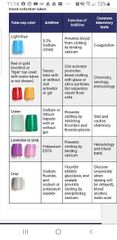
|
|
|
Additive |
Chemical added to evacuated tube |
|
|
Antiseptics |
Substance that prevents infection. |
|
|
Bacteriostatic |
Agent that prevents growth of bacteria. |
|
|
Butterfly/ winged infusion set |
Small needles and flexible tube for delicate veins |
|
|
Clot activator |
Additive that stimulates clotting |
|
|
Disinfectant |
Agent used to clean a surface than living tissue |
|
|
Gauge |
Number describing the diameter of a needle's lumen. |
|
|
Glycolysis |
Metabolic sugar breakdown within cells. |
|
|
Inpatients |
Patient admitted to the hospital |
|
|
Luer adapter |
Device for adapting a butterfly needle to and evacuated tube |
|
|
Lumen |
Hollow tube within a needle |
|
|
Multisample needle |
Double-ended needle design to be used with and evacuated tube system |
|
|
Order of draw |
Prescribe sequence in which tubes with different adhesive should be filled during a multitube collection. |
|
|
Outpatient |
Patient treated at a hospital without being admitted as an inpatient |
|
|
Polymer gel |
An inert, synthetic additive used to separate cells from plasma during centrifugation; also call thixotropic gel. |
|
|
Thixotropic gel |
Inert additives used to separate cells from plasma during centrifugation. |
|
|
Tourniquet |
strip of material used to reduce circulation and increase prominence of vein |
|
|
Tube advancement mark |
Mark on a needle adapter indicating how far the tube can be pushed in without loosing vacuum. |
|
|
Tube holder/ needle adapter |
Translucent plastic cylinder connecting a multisample needle to an evacuated tube. |
|
|
Whole blood |
Blood before its separated |

